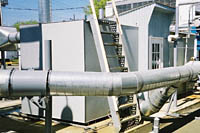VOC Compliance Cost Reduction

Operations management at International Paint LLC reports dramatic savings in compliance costs for VOC emissions, through replacement of a gas-fired thermal oxidation afterburner with a 3000-cfm combination biofiltration and carbon adsorption, "end-of-pipe" VOC-removal system. They also report eased operational burden for VOC control and improved internal air quality, through elimination of "greenhouse gas" and other afterburner emissions.
The SYNERGY™ system was designed, manufactured and installed by Biorem Technologies of Guelph, Ontario, per 90% VOC destruction criterion provided by the plant. Consulting engineering services were performed by Environmental Engineering Corp. of Madison, NJ, within their ongoing responsibility for state air quality permits for the site.
Return on Investment
"While we were realizing very high levels of VOC destruction with the afterburner, it was costing us $50,000/yr for natural gas, and this then went up to nearly $170,000, which represented a significant portion of the factory's operating budget," recalled Michael Del Mauro, vice president, operations, for the company's North American plants. "The new system represents excellent value returned for the investment. In a climate of spiraling gas and energy costs, the $200,000 spent was very quickly recovered."
"In addition," he continued, "we no longer have to worry about monitoring carbon monoxide from the afterburner, where we were limited to 50 parts per million (ppm) at 21% oxygen by the permit conditions. That eliminates a significant operational burden for ongoing testing, calibration and reporting."
"The new system has been much easier to operate," he concluded. "We turn it on, we walk away from it. And we no longer have the diesel-like odors we used to get from the afterburner. Visitors tell us they didn't realize they were in a paint plant. They ask if we make paint here, or is it just a warehouse." For Biorem, the application represents significant progress in its commitment to expand the limits of biofiltration for VOC control.
"The SYNERGY system, consisting of a biofilter with inorganic media, used in combination with carbon adsorption and ongoing regeneration of the carbon, is installed here to take biofiltration to the next level," noted Derek Webb, P. Eng., and director, Industrial Group. "VOC mixtures like these are complex and recalcitrant, with their low water solubility, high molecular weights and strong chemical bonds making them very hard to degrade."

Originally established in 1913, the Union, NJ, plant currently produces solventborne paint systems for the yacht and marine markets. While a great deal of effort has been spent on the development of low-VOC-based systems, in many cases the technology is not currently available to do that and still meet the flow and application properties required by the most demanding customers.
Consequently, efforts to further control VOC have had to focus on "end-of-pipe" abatement techniques to handle xylene, ketones, alcohols and other solvents. By the mid-1980s, the Akzo Nobel-owned company became actively interested in better emissions control, even though the plant was already in compliance.
"We are very much a part of the local community, and want to be seen as a good neighbor, so even though there were no overt problems, we wanted to eliminate as much odor as we could, taking us even further below compliance limits," said Del Mauro.
He noted scrubbers were considered initially, but deemed insufficient for xylene and other VOC removal, and a carbon adsorption unit was selected around 1990 as the plant's first end-of-pipe control technique.
Two granular activated carbon (GAC) units were connected in series on a 5' x 5' pad, with each unit containing over 300 trays of adsorbant. Originally, the plant was able to readily recycle and regenerate the GAC, but then new regulations governing local regeneration contractors mandated changing to a procedure of disposing of used GAC and replacing it with new material.
With the used GAC designated as a flammable solid requiring disposal as hazardous waste, the combined cost of disposal and new GAC exceeded $100,000 annually. In addition, changing trays was a labor-intensive operation that had to be performed when the plant wasn't operating, thereby adding overtime costs, in order to avoid emissions violations. And there were additional burdens of continuous hydrocarbon monitoring of the trays, including daily instrument re-calibration, in order to watch for break-throughs. If ketones were escaping, there was also an ignition hazard when they came in contact with the GAC.
After about three years, the new costs and operational burdens drove a search for alternatives. Scrubbers were again considered, this time with improved capability for removing VOCs, but with the disadvantage of adding a hazardous waste problem as a result of their process water combining with the VOCs to form a slurry. The only viable alternative was deemed to be a thermal oxidation afterburner - not an incinerator, which was barred by state law.
While resultant VOC destruction was very high at 1500 °F, natural gas costs became more and more prohibitive, and carbon monoxide emissions from the afterburner had to be kept under 50 ppm at 21% oxygen and under 30 ppm at 17% oxygen.
These factors, along with out-of-pocket needed to cover comprehensive compliance reporting and cylinder gas audits, the equipment nearing the end of its 15- to 20-year projected service life, and its vendor going out of business, making servicing increasingly difficult to obtain, drove another new search for alternatives.

The plant's environmental consulting firm, Environmental Engineering Corp., led the new search. They had helped specify the afterburner, but had later noted that the unit's natural gas usage needed to achieve operation at 1500 °F, had become excessive when paint production and consequent VOC emissions decreased. Then the surge in gas prices made its continued use prohibitive.
"The alternatives considered included solvent recovery, recuperative thermal oxidation with higher heat recovery, regenerative thermal oxidation, catalytic oxidation, and biofiltration," recalled Pradeep Lamba, the firm's principal. "Catalytic oxidation was not selected because of concern about fouling of the catalyst by some of the raw materials being used at the facility. Solvent recovery was not selected because the facility uses a large number of solvents, and the recovered solvent mixture could not be used there. Biofiltration was selected because it had the lowest operating cost, while its capital and installation costs were similar to the other technologies."
"Two vendors for biofiltration were selected for evaluation based on their experience with similar projects and their unit costs," he continued. "Biorem was selected for the pilot test because their unit used a carbon adsorption system after the biofilter. With biofiltration a relatively new technology, the presence of the backup carbon provided an additional level of safety in achieving the VOC removal efficiency required by the facility air permit. This additional safety was gained without any significant increase in operating costs because the carbon part of the unit was regenerated by using the biofiltration part."
Plant management described additional factors noted during the investigation of the two biofiltration alternatives. The Biorem unit, Del Mauro said, "was more comforting at four or five times the size, came with a control package that made it simple to operate, and was backed up by an engineering support staff that really knew what they were talking about when we had their salesman relay our questions. They were much more of an established company. So I went out on a limb and asked management for the investment, even though my associates here were laughing at me. We got an agreement that if we bought the system, pilot testing would be provided free of charge."
The unit was installed in May, 2005, and required about six weeks to be fully up and running. It handles all emissions from the plant, with the fume-laden air stream collected at the plant's filling machine and manufacturing tanks, and particulate filtered out in a baghouse before the remaining airstream is ducted to the VOC removal unit at 3000 cfm.
The biofiltration medium digests VOCs, with about 80% removed at that stage. The airstream then continues to a carbon bed chamber, where removal reaches 90-95%, as monitored daily with a hand-held flame ionization detector. In regeneration mode, the carbon bed is heated by a 5 HP boiler that is also taken advantage of to heat the plant's hotbox for high-viscosity resins.
VOCs are stripped off the carbon bed and are circulated back in a closed loop to the biofiltration medium while the plant is idle at night. There are no greenhouse or other emissions from the new VOC-removal system that require monitoring.
Biorem's primary system design criterion was to provide greater than 90% VOC destruction. After initial installation, they worked with the plant for about five weeks to establish fully effective operation. Minor additional expense was needed to get the system's dampers in sync with actuators for dampers already in the plant, whose process steam was used in turn to help heat the carbon adsorption portion of the new system.
Del Mauro reports greater than 90% VOC destruction most of the time, with levels typically at 96-97%, and the lowest recorded at 88%. Plant permit limit, as negotiated by their engineer, is 75%.
Biorem, established in 1991, offers a comprehensive monitoring and support program for its biofilters and media. Its resources include experienced engineers, chemists and industrial microbiologists, and state-of-the-art laboratory and research facilities.
For further information about solutions to odor control problems, contact BIOREM Technologies Inc., 7496 Wellington Road 34, RR #3, Guelph, Ontario, Canada N1H 6H9, phone 519/767.9100, fax 519/767.1824, e-mail info@bioremtech.com, or visit www.bioremtech.com.
Looking for a reprint of this article?
From high-res PDFs to custom plaques, order your copy today!




